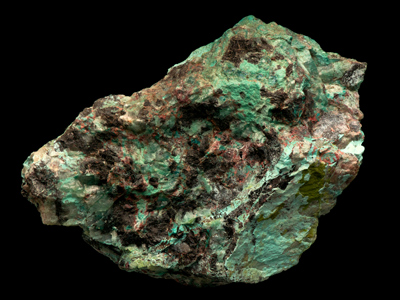
Ask the AI Tutor
Need help with Chemistry - Extracting Unreactive Metals (AQA)? Ask our AI Tutor!
AI Tutor - Lucy
Connecting with Tutor...
Please wait while we establish connection

Carbon is more reactive than copper, which makes it is relatively easy to extract from ores.
Chemistry - Extracting Unreactive Metals (AQA)
Some metals are so unreactive they can be dug up almost pure. Discover how gold, platinum and other native metals are mined and separated from rocks.
1 .
What is the special name given to the process of extracting iron from iron ore in a blast furnace?
Melting
Smelting
Welting
Spelting
Smelting is also applied to any metal extraction process involving heat and producing the molten metal
2 .
Why can gold be found in the Earth's crust in its native state?
Gold is very rare
Gold is very unreactive
Gold is more reactive than lead
It came to Earth on meteorites
Silver can also be found native, even though it is more reactive than gold
3 .
Which of the following statements is correct?
Iron oxide in a blast furnace is oxidised to form iron
Iron oxide in a blast furnace is electrolysed to form iron
Iron oxide in a blast furnace is melted to form iron
Iron oxide in a blast furnace is reduced to form iron
In order to obtain any metal from its oxide it has to be reduced
4 .
What is the main impurity in iron from a blast furnace?
Carbon
Oxygen
Unreacted iron ore
All of the above
Iron straight from the blast furnace contains about 4% carbon, which makes it very brittle
5 .
During the process of smelting, what happens to copper ore?
It is oxidised
It is reduced
It is augmented
It is increased
Most metals are extracted from a metal oxide and copper is no exception. When oxygen is removed from a chemical, we say it has been reduced
6 .
Carbon can be used to remove the oxygen from copper oxide to leave the copper. This contains impurities including carbon. How is this copper purified?
Filtration
Centrifuging
Electrolysis
Double reduction
The impure copper is used as the anode. Copper ions are attracted to the cathode but the impurities are not and simply drop to the bottom of the reaction vessel
7 .
It is said that by the middle of the 21st century economical copper ores will have been used up. New ways of extracting copper from low-grade ores are being researched. One of these is called phytomining. What does phytomining involve?
Using high powered lasers to blast the copper from the low grade ore
Using plants to absorb the copper compounds from the ores then burning the plants
Using the low grade ores with a mixture of chemicals that will dissolve the impurities
Using radioactive filters to get rid of the impurities
When the plants are burned, the ash is high in concentration of the copper ores. This could be used for other metals too as their best ores start to run out
8 .
Another idea is to dump scrap iron into solutions of copper salts. How would this work?
The iron would corrode which would push the copper out of solution
The iron would take any oxygen from the salts leaving behind pure copper
The iron would displace the copper from the salts
The iron would be reduced which would cause the copper to be deposited all around the inside of the reaction vessel
Iron is more reactive than copper and would displace it from solutions of its salts
9 .
Bioleaching is yet another idea for getting metals that are less reactive than aluminium from very low grade ores and wastes. What organisms are used in this process?
Protozoa
Fish
Leeches
Bacteria and fungi
There are many advantages and disadvantages of bioleaching. The process is simpler and does not require complex equipment but it is much slower than conventional methods, meaning that it takes longer for a company to earn the money back that they spent on setting it up
10 .
The most common ore of tin is cassiterite, a form of tin oxide with the formula SnO2. Which of the following is a balanced equation showing the extraction of tin from this ore?
SnO2 + 2C → 2CO2 + Sn
2SnO2 + 2HCl → 2Sn + H2O + 2ClO
SnO2 + H2 → H2O + Sn
SnO2 + C → CO2 + Sn
This question tests both whether you know that tin, an unreative metal, would be extracted using carbon, and your knowledge of balancing equations
**Unlimited Quizzes Await You! 🚀**
Hey there, quiz champ! 🌟 You've already tackled today's free questions.
Ready for more?
Ready for more?
🔓 Unlock UNLIMITED Quizzes and challenge yourself every day. But that's
not all...
not all...
🔥 As a Subscriber you can join our thrilling "Daily Streak" against other
quizzers. Try to win a coveted spot on our Hall of Fame Page.
quizzers. Try to win a coveted spot on our Hall of Fame Page.
Don't miss out! Join us now and keep the fun rolling. 🎉
**Unlimited Quizzes Await You! 🚀**
Hey there, quiz champ! 🌟 You've already tackled today's free questions. Ready for more?
🔓 Unlock UNLIMITED Quizzes and challenge yourself every day. But that's not all...
🔥 As a Subscriber you can join our thrilling "Daily Streak" against other quizzers. Try to win a coveted spot on our Hall of Fame Page.
Don't miss out! Join us now and keep the fun rolling. 🎉






